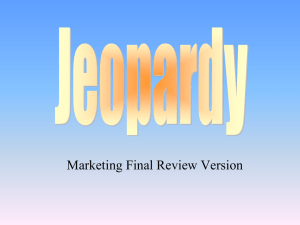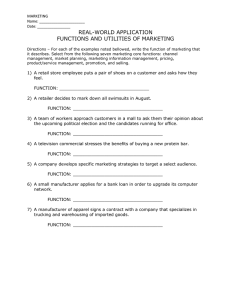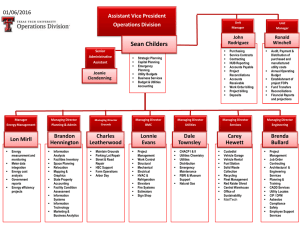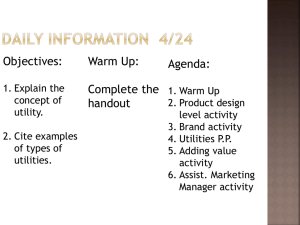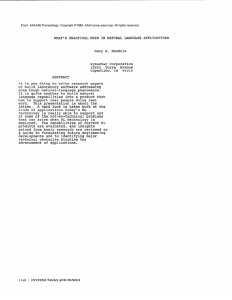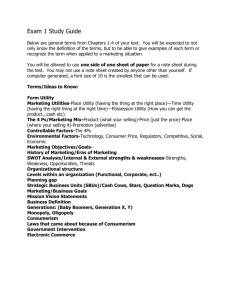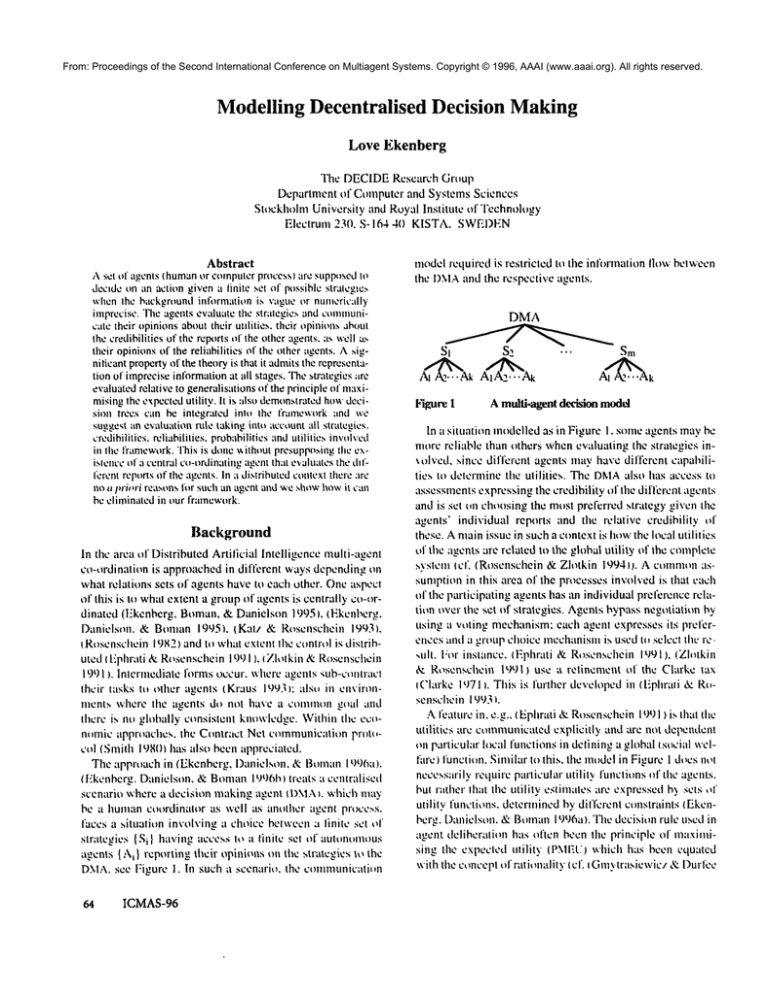
From: Proceedings of the Second International Conference on Multiagent Systems. Copyright © 1996, AAAI (www.aaai.org). All rights reserved.
Modelling Decentralised
Love
Decision Making
Ekenberg
Thc DECIDEResearch GrtJup
Department of Computer and Systems Sciences
Stockholnl University and Royal Institute of Tcchnoh~gy
Electrum 230. S- 164 40 KISTA. SWEI)I-:.N
Abstract
A set of agents t humanor computerprocess} tire supposedlO
dec~dcon an action given z, lmite set of possible straleglc.,
whenthe backgroundinl’t~rnl:~titm is vague or numerically
imprecise. Theagents evaluate the stralegie.~ :rod communicate their opinionsaboultheir utdities, their opinion.’, about
the credibilities of the reports of the other agents. :is well a.,,
their opinionsof the reliabilities o1" the other agents. A ..,igniticant propertyof the theory is that it admitsthe representation of impreciseinform.’~tionat all stages. Thestrategies are
evaluatedrelative to generalisations of the p,’inciple of maxiraising the expectedutility. It is also demonstratedhowdecision trees can he integrated into the framework :me we
sugge,~t:m evaluationrule taking int¢~ act’~unt all strategies.
credibilities, reliabilities, probabilities andutilitie.~ involved
in the framework.This is done~ itht~ut presuppo.~ingthe exi.’,lencc o1 a central co-ordinatingagent that e~.aluatesthe thfferent repurts of the agents. In :t distributed context there are
no tl priori reasonsIbr such art agentandv..e shL~w
howit f;.tn
be eliminated in our framework.
Background
In the area of Distributed Artilicial Intelligence multi-agent
co-ordination is approached in different ways depending on
what relations sets of agents have to each other. One aspect
of this is to what extent a group of agents is centrally co-ordinated (Fkenberg. Boman. & Danielson 1995 I. O~kenbcrg.
l)anielscm. & Boman 1995"L I.Kal/ & Rosenschein 1993J.
!Rt~senschein 1982) and t~ what extent Ihc ctmtrol is distributed (Ephrati & Roscnscl|ein 1991 ). ~Zlotkm & Roscnschein
1991 ). Intermediate I’orms occur, where agents ,~ub-cnnt]acl
their tasks ttJ other agents (Kraus 1993): alsu in cnvirnnIllClILs wherethe agents dr) II1.11 have a Cl.ll|lltl()ll
g~al and
there is no gh~bally consiste|tl km~wlcdgc.Within the et:~mDnlic appn~achcs, the Ctmtract Net communication prt~t¢,col (Smith 19801 has also been appreciated.
The :.tpprt~;.tch in (Ekenberg. I)anielson. &]]onran It)gOat.
(t’kenhcrg. Daniclstm. & Bomanl gt)Ob) treats :t centraliscd
scenario wherea decision rn:tking agent t l)MAI. whichnut.,,’
be a hulllan
coordinator
as well as allt)lhgr
agent proce:,s.
faces a situation involving a choice between :.t linitc set of
str:ttcgies {St} having :recess to :t linitc set of aultmolnt:ttlS
agents {A~}reporting their opinitms on the strategies to the
DMA.see Figure I. In such a scenario, the communicatitm
64
ICMAS-96
model required is restricted t1.~ the information Ilow between
the I)MAand the respective :tgenls.
DMA
SI
Figure I
52
---
Sm
A multi-agent decision model
In ~, situation modelled as in Figure 1. someagents may he
nit)re reliable than others whenevalu:tting the strategies in’~t)lved. since different agents mayhave different capal~ilitics It) deternfine the utilities. The DMA
:rise has access to
assessments expressing the credibility of the different agents
and is set t,n choosing the most preferred strategy given the
agents" individual reports and the relative credibility of
these. A main issue in such a context is howthe local utilities
uf the :tgents are related to the global utility of the con’tplele
s,.,slelll
tel’.
(Rosenschein&Zlotkin 19941.t. A ct)lllnlon
assuntption in this at’ca of the processes involved is that each
of the participating agents has an individual preference relation ~wcrthe set t~t" strategies. Agents bypass negt~tiatitm by
using a voting mechanisrn; e:tch agent expresses ils prcfcret|ces and it group choice mecltanismis used u, select the re.
¯,ttlt. l:or instance, tF..plmtti &Rt~senscheinItJ91). (Zh+tkin
& Roscrtscheflx 1991~ use a relincmetlt of the Clarke tax
cClarke 1971 I. This is further developed in <l-phrati &R¢,senschein 1993~.
A feature in. e.g.. I Ephr:tti &Roscnschein1991) is thai the
utilities arc cotrununicatcd explicitl}, and are not depentlcnt
on particul:tr htcal functions in dctining :t global Isucial welfare) functiun. Similar to this. the int+de] in Figure I does not
necessarily require particular utility funclitms nf the agents.
but rather Ihat the utility estimates are expressed h) sets ,11’
utility functions, determined by different ct>nstraints (Ekenbc,’g. Danielson. & Boman1996a). The dccision rule used in
agent tleliherati~m has nftcn been the principle of maxintising the expected utility {PMI-t.~ which has been cqu:ttcd
with the conce]~l t~l" rationality tel’. IGnl,,.tr:isicwic/& l)url~.’e
From: Proceedings
of the
International
Conference
onfrom
Multiagent Systems.
Copyright © 1996,
(www.aaai.org).
Allin
rights
1993)).
This equality
is Second
inspired
by research
that grew
on the reliabilities
of theAAAI
other
agents as they
turnreserved.
assess
efforts of Ramsey. yon Neumann.and others cFishburn
the abilities of other agents. Eachagent has such capabilities
1981). It should be emphasizedthat even though this paper
of expression since there are no coordinating agents or gloassumes the underlying use of the PMEU.
this .’tssumption
bal credibilities involved. This modelis restricted in the
can be relaxed (Bom:m&Ekcnberg 1995j. (Ekcnberg, Dasense that there are no goodanswers to whywe should stop
here. The agents could also have opinions on the reliability
nielson, & Boman1996b).
Anotherimportantissue is that for a set of agents It, perof the other agents whenthey in turn assess the reliability of
form adequately, it seemsimportant that the agents are able
the other agents. Furthermorethe agents mayhave opinions
to evaluate vague background information gathered from
tm the abilities of the agents whenstating the latter kinds of
different sources. The dynamicadaptation taking phtce over
assessments, etc. Theoretically, this viewpt~int implies an
time as the agents interact with their environment,and with
intinite regress and makesthe problemintractable, but a reaother agents, is affected bythe means:lv,’dl.’thle to assess and
sonable, albeit unjustified, assumptitmis that the assessevaluate impreciseinformation. In this respect. ~,ur concern
mcnts converge alter a few levels. The description in this
has been howproblems modelled by numerically imprecise
section is restricted to a case with three kinds of assessprobabilities and utilities can be evaluated. Muchwt,rk has
ments, but as will be seen later, the modelcan be extended
been done in this area and the relation betweenour workand
to take account of an arbitrary number,,f assessmentstypes.
earlier approachesthat attempt to incorp,~rate impreciseesAs an examplehowthis modelc’m be used, consider the foltimates into probability theory is described in (Ekenbcrg
lowing:
Danielson 1994). Our approach attempts t. conformto tl’aExample:
A set of agents (AI and A2) are to report on their
ditional statistical reasoningby using the concept of admisrespective assessmentsconcerning the strategies for a risk
sibility (Lehmann1959). The theory maystill be used
policy of a company.The objective for the agents is to devaguedomainsand it avoids restricting assumptionssuch as
cide howto allocate resources for preventing potential losscommonknowledge, precise utility measures, and a depenes of the comp:my.The prevailing strategies are t,, prevent
dence on axiomatic ch:tracterisations (Rosenschein1988).
disruption of productions and services, to prevent obstrucAn obvious disadvantage with the model in Figure I is
tion of research and development,or to distribute the rethat there are not alwaysa priori reasons for choosinga spesc,urces over both these objectives. These strategies arc
cilic DMA,and one purpose with this paper is lO alh~wfor
labeled St. $2. and $3 below. Assumethat the agents AI and
the DMA
to be removed. The next section presents an apA
2 have reported the followingutility assessments.The utilpruach where the agents have access to a mechanismfor
ities
involved could, for example, be monetaryvalues. In
communicating
constraints on their individual utilities and a
that
case.
they are linearly transformedto real values in the
decision rule that evaluate a global utility fromthi.,,. Since
such a structure requires qualified reports from each of the
interval[0. I lagents, the agents should also have access to a general
For instance, the assessmentsaccording t. agent AI could
frameworkfor evaluating the possible strategies from their
be the ft~llowing:
ownviewpoints. Such a frameworkis investigated in the
¯ The utility of strategy S I is between0.20 and 0.50
second part of this paper, which describes ht~wagents may
¯ The utility of strategy $2 is between0.20 and 0.60
use decision trees to evaluate different strategies with re¯ The utility of strategy $3 is between0.40 and 0.60
spect to imprecise backgroundinformation.
¯ Theutility of strategy $2 is at least 0.10 better than that
of S I
Global Utility
Agent
A2 can state similar assessmentsabout the utilities
Thefirst step to eliminate the DMA
is tt, distribute the possit~l"
the
strategies. Notethai the utility’ estimatesare treated
bility to estimatethe credibility ol’the agents. Asin the modonly
from
a global perspective. Below. we will discuss how
el in Figure I. each individual agent may express its
the
agents
mayuse decisi,m trees in imprecise domainsto
respective opinion about the utilities of the strategies under
individually
perform evaluations of the strategies. (Risk
consideration. However.it maystill be that different agents
mayhavedifferent capabilities to determinethe utilities, and
evaluation methodsthat can be integrated into the framethis section suggests howthe possibility to makecredibility
w(~rkare discussed in (Ekenberg&Daniels.n 1995:t. (Ekenassessmentscan be distributed.
berg. Oberoi, &Orci 1995)1.
Moreover.
the agents mayestimate the credibility ,,1 A
I
Representation
anti A2as numbersin the interval [0,11. The number0 denotes the lowest credibility and I the highest. Thus, the asThe agents are asked to assess the competenceof the t)thel"
sessments
according Io agent AI could be:
agents in two respects: (i) they mayhave t,pinions on the
¯ The credibility of agent A2 Iis at least equ:d to that ofA
other agents" abilities to give adequateestimates tm the utilities of different strategies, and (ii) they mayhaveopinions
¯ The credibility of agent A2 is between 0.30 and 0.70
Ekenberg
65
From: Proceedings of the Second International Conference on Multiagent Systems. Copyright © 1996, AAAI (www.aaai.org). All rights reserved.
The assessments according to agent A2 have a similar
fornl. Furthermore,the agents have estimated the reliabilities of Ai and A2as numbersin the interval [0.11. Thenumber 0 denotes the lowest reliability and 1 the highest. For
instance, the assessments according to agent AI can be:
¯ The reliahility of agent Ai is between0.50 and (1.70
¯ The reliability of agent A-, is between0.2{) and 0.50
Onefurther reason fi~r :tllowing interval :is well as colnparative assessments is that the agents" informatitm may
have different sources. For instance, intervals naturally occur from aggregated quantitative information while qualitative considerations often result in comparisons. Since the
st~urces maybe different, the assessmentsare not necessarily
consistent with each other.
Example (eont’d): The reports provided by agent t are
transklted to the followingexpressions.
Ull E [0.20, 0.501
u21~. 1{).20.0.6{11
u3t ~ 10.40. 0.601
u21_> Ull + 0.10
The
2 credibilities as well as the reliabilities of AI and A
;.fie also representedas numbers
in the interval [0. I]. :rod the
translation of the credibility and the reliability assessments
aboveresults in the following expressions.
ct2 E 10.30.{).7{)1
Cl2 > ell
rlt c 10.50, 0.70]
r12 ~ [0.21). 0.501
"]’he sets of assessmentsarc transformedinto linear systems cff cqu:ltions that are checked for consistency The
credibility assessments,reliability assessments,.’rod utilitv
:issessmentsconstitute the credibility base’~., the reliability
base R. and the ~’trate~y base 5 respectively. A credibilily
base with k agents is expressedin the credibilil), varinhle.,,
{ Cl I ..... c I k ..... ck I ..... Ckk} statingtile relativecredihilit
vof
the diffel"ent agents whenc,nsidering the strategies. "[’he
ter,n cij tlcnotcs the tJpinion ~1 agent Ai aboulthe credibility
of ~gent Aj’s utility estimates. A reliability base with k
agents is expressed in the reliability
variables
{ r I I ..... r lk ..... rkl ..... rkk } statingthe relati,,ereliabilit), of
the diffc,’ent agents. Thetc,’m rij denotesthe ,’cliability of
agent A.i acct~rdingto agent Ai. Thecredibility and reliability bases are also restricted by normalisationctmslrainls
k
’~ Cij
I .I
k
= I
:lnd E r j = 1.
i-=l
for each agent Ai inxolvcd. A strategy base ++.ith k agcntr,
and m st,ategies is expressed in strategy v.’triat+les
lull ..... Ulk..... Uml.....
gics ;.tccoJ’dingIt> the
66
ICMAS-96
Unlk}slating the utility td" the Stl’;.tlc-
different agents. Tile Icrrn tlil
denotes
the utility of strategy Si in the opinionof agent Ai. Thethree
basestogetherconstitutean it,.l’t~rmtttiottfrltme.
It is assumed
that the variables" respective ranges are real numbersin the
interval [0. I1. Below,wewill refer to an inl’t~nmttionfr:tme
as a structure(5, K-"e,.).
Wcwill nowprovide a more detailed description of how
problems,arising wheneliminating the central position of a
coordinating agent, are handled. Webegin by discussing the
representation and properties ~1" assessmentsof agent c,’cdibility, agent reliability, and utilities of strategies acctwding
to the different agents.
Evaluation
In eliminating the DMA
we t,btain three different bases lu
consider in Ihe evaluation p,’t~ccss. Theglobal utility of a
strategy is a functitmof the reports t~l" tile individu:dagents.
the agents" credibility whengiving such reports accordingto
the other agents, and all agents" opinions on each others reliability. Theintuition for the formulaexpressingthe global
expectedutility is that all assessmentsconcerningthe utilities of the strategy Si are taken into accounl, each of which
is balancedwith the different credibility assessments."File
credibility assessmentsare in turn balancedwiththe rcli~,bility assessments.
Forinstance,uilcI I. i.e. the utility., t~l strategy Si in tile opinionof agent AI weightedby the crctlibility
td" agentAt accordingto itself, is weighted
bythe ,’eliabilit.,,,
of agent A1 accordingto all agcnlsin the system.Tile re~,t, lting expressionof this is
U~lCllrll
+UilCllr21 +-.- +tlilcllrkl¯
Similar expressions are received for all terms and the restilting expression whenall :tssessments are taken inlo accountis then (except for a normalisationI’:lctori
Uilt_’llrll
+ Uil¢llr21 + ...
+ ui2cl2rll + ...
+ tlikgkkrkk.
In the remainingparts uf this section, the inform:~tion
frame(5. K, ’-~.) is supposedtl~ represent a sx;stem with
agents :rod mstrategies.
l)efinition i
Givenan informatitmframe(5. ’-(.. :t(). .eh,hal cXlW
Cted
utilily (;(St) of a str:ltegyS, is:
I
("J(’Si’l
k
k
k
= k E Z E tlil’t’nn’l’lln,
j-: lu’h- 11"t = 1
whc,cuij. cij. andrij :,re ~.ariablesin 5. K. and’.~.. icspcctivclv. ¯
This expression should be evaluated with respect t,~ the
ctmstraints in the infomlation frame. Ilowevcr. since tile
agents are nt~l necessarilyconsislent in their cstim:ltes, tile
lir,;t ..,top of the evaluationprocetlureis to determinetile solutitmsetsto ’A.’.. "~.. andS.
From: Proceedings of the Second International Conference on Multiagent Systems. Copyright © 1996, AAAI (www.aaai.org). All rights reserved.
Definition 2
Alist of numbers
[n I .....
nk] is a sollttion rector to a baseX
containingvariablesxi, wherei = I ..... k, if ni can be consistently substituted for xi in X. Theset of solution vectors to a
base constitutes the solution set. This set is a convexpolytopc, i.e. an intersection of a linite numberof closed half spaces. ¯
Thc solution sets to the bases can be determinedby ordinary linear programming
(LP) methods.In order to deline
evaluation principle, a notation for instantialions of the global expectedutility of an strategy is introducedbelow.
Definition 3
Givenan information frame (3. K. R). l.et a. d. and e
three vectors of real numbers(all .....
(e I 1 ..... ekk).
k k
I
aik). I I I .. ... dk k.J, an d
k
= E E E
j=lm=ln=l
whereaij. dij. andcij are numbers
substitutedfor ui.i. el.i, and
rij in G(Si)I.
The evaluation an alternative can be based on the c~mcept
of admissibility. This intuitively meansthat a strategy is admissible iff no other strategy is better w.r.t. (X "~. R). Thus.
a strategy Si is admissibleif it has specific properties w.r.t.
the inl’ormation frame underconsideration. The t in the expressions belowis a real numberin the interval It), I1 introduced for studying howlarge the differences between the
expectedutilities arc.
Definition 4
Givenan information frame (X K, ~.) and a real numbert
the interval[0, I I.
is at least as t-,~’ood as Sjiff ald~e~G(i )- :t .icl.icrG( SI ) - t _>
for all ai. da, el. aj. di. ej. whereai and:~i are solutionvectors
to S, di anddi are solutionvectorsIo .Tk:. and ei and cj are solution vectors to ~.
Si
Si is at least as t-goodas Sn and
aldi":~G(Si) - a.idicjGI S.i) - t > forsome
%di. ci. aI . dj. ej .
dure. Instead, we use procedures for reducing problems of
this particular kind (i.e. whenthe bases are separated)to linear systems, solvable with LP methods(Daaielson & Ekenberg 19967.
Usingthe above delinition, the strategies are evaluated
with respect to (S, K. R) and one of three situations mayoccur. For a real numbert:
(it Nostrategy is t-admissible
(ii) Onestrategy is t-admissible
(iii) Morethan one strategy is t-admissible
Case (it has no solution. For case (ii) the task is done,
since the only remainingstrategy is superior. Case(iii) remains, which implies a set of seeminglyreasonable strategies containing more th:m one clement. Whenthis ease
occurs, admissibility seems to be too weakto form a decision rule by itself. Wehaveearlier suggestcddifferent principles for further discriminating rules for centralised agent
systems (Ekenberg & Danielson 1994). (Ekenberg, Danielson, &Boman1996a). but they can easily be adapted to the
extended information frames. A class of techniques is also
discussed in eDanielson &Ekenberg19967. Using such procedures, incomingreports from agents with varying degrees
of reliability can be evaluated in order to reach an informed
decision based on possibly deviating report contents.
Decision Trees
The modelused above requires muchresponsibility li"om the
agents in the systemsince all agents are allowed to participate in the decision process. Consequently,for the agents to
producequalilied deliberations, they should be able to evaluate the strategies underconsiderationin a qualilied way.In
the section above, the problemwas modelledwithout taking
into account howdecision makingagents arrived at their
preferences and there were no requirements on the methods
they used in this process. By extendingthe conceptof strategy, and using techniques similar to those proposed above.
more general decision modelscan be evaluated. Consider a
traditional decision modelin Figure 2.
Si is t-better than Sjiff
S
I
S
2
¯ ..
S
n
S
t
ell
el2
...
Cln
whereai and a.i are solution vectorsto 3. di and dl arc solutiun
vectors to "(. and ei and ej are solution vectors to R.
S2
c21
C22
...
C2n
Si is t-admissibleiff no other Sj is t-better. ¯
Sm
CmI
""
Cam
Thesedefinitions (fl~r t = O)ctmformto statistical decision
theory (Lehmann1959). and can be used below when comparing different alternatives. In the general ease, determining admissibility is a fairly demanding task from a
computational viewpoint. Consequently. general methods
are not suitable for interactive use of Ihe evaluation proce-
I,igure2
era2
A state-t~mequencematrix
"rhe possiblestates (s I ..... Sn) in the modeldescribea set of
nmtually exclusive and exhaustive descriptions of the world.
n,~t leavin,, any relevant state out. Theseslates determinethe
consequences(such as %j) of the different strategies (alterEkenberg
67
From: Proceedings of the Second International Conference on Multiagent Systems. Copyright © 1996, AAAI (www.aaai.org). All rights reserved.
natives}SI ..... Sm.Thetrue state is the state that does eventually t,btain the description of tile actual world. Thus. if
we adopt lhe strategy S2 and if s3 becomesthe true state.
consequencec23 will occur. The preferences amongthe consequencesare supposedto be expressed by somekind of value function,for instancea utility funcl,itm. If such a I’unctitm
exists, the value of ctmsequenceeij can be mappedonto zt
value vii. and the matrixcan be evaluatedwith respect to differcnl, evaluation rules that have been proposedduring the
years (el. (Ekcnberg. l)aniclstm. &Boman1996b)).
motlel is formul.’|l,ed in termsof a single decisionnode.i.e..
whena decisitm makingagent have only tree decision tt~
make.This is unnecessarily restrictive, since an agent often
confrtmts a decision situatitm involving paths with several
decision nodes. (of.. e.g.. (Raiffa 19681). Sucha situatitm
can bc nlodelled in a decision tree such as in Figure 3. The
dirccl,ededgesI:lbcllcd byS in the ligure denoteall,ern.’ll,ives.
:rod the o’s different consequences.Thesquares are decision
nodes, i.e.. wherea decision has to be madeby an agent. Tile
circles denote chance nodes, fromwhich edges lead to
leaves or newdecision nodes. Finally. the leaves correspond
to ultimate consequences.A directed edge labelled by p denotes the probability of the node wherethe edge terminate.
~iven that the altern.’tl,ive (leading to the chancenodewhere
p begins) t,ccur.
ecl edge leading to a decision node. Thegeneral case is very
similar.
Definition 5
Givena decisionl,ree. Aset { Oil ..... ci,i,Dit:,i+l)} is an alteroalive associated with a chancenode (’i. if the elementsof
the set are exhaustiveand pairwisedisjoint wil,h respect I,o
Ci. (This nutation will be used eveni fan ahernativeriots not
Ct)lll,ain all CIelncnt.[.)0 st+I
)),
Infurmally.this meansthat exactlyone ~d" Oil ..... cisi.Du..i~.l
~
will occur given that the alternative, representedby tile directed ed,,e~,to Ci is chosen.
Definition 6
Givena dccisiuntree. a seqtzcnccof edgesISI ..... S,I is a
strategy,if l’~)r all elementsin the set. i Iisa directed edg
e
frt,m a decistere nodeto :1. chancenodeCi I" andthere is a directed edgefrom Ci .I to a decisinn nodefromwilich Si is a
directed edge. ¯
Definition 7
Given:m agent A. a dccisiun tree associated witll A. and a
strategy [S1 ..... St], whereeachSi is all alternative, i.e.
{ ell ..... Cisi.Dil.,i+l ] } associatedwitha chancenodeCi. Tile
c,.~qwc/cd
utility o./’/ SI ..... St] withrespectto ageotA,
F.AtSI..... Sr). is delined by the following:
E’X(si ) = ~ Pii’uq
I=I
whenSi is an alternative {Oil
..... Cisi
xE
.
tSi ..... Sr) = Zpfi uii÷(’Pji.,~-I,
j= I
whenSi is an :dl,ernalive{Cil
.....
}. and
. A
E (Si. ..... S
j
r)
ci.N.Ditsi+l
i}.
uij denotesthe utility of the consequence
ci. i. and Pn.j demotes
tile pr(~babilil,y
of tile ct)rl:,.,etlucn,,:ecii (or [)~l). given¯
Figure3
Al)eci, donTree
This modelcould be extended in a way similar to betbrc
hy allowing I’,r imprecise assessmentssuch as "’tile probability of consequencec~. I t~bl,aining is in the interval
14(1u.6o’~
i’" ,,r or,reparative assessmentssuch as "’cnnsc.
quencc c U is prcfcrrcd to Ct)llSCt.lUeliCe Ckl". Theseasscs>menl,s c.’m be represented in sysl,erns of linear inequalil,ies in
probabilityv:u’iables Pij andutility variablesui. i. Similartt)
befure, the lirst asscsstnentcan be represenl,edby the l,wo illequalil,iesPij -> 4¢)’,.~:rod Pij <-- 60:;~. andthe sectmtloneby
uij -> Ukl.Tusimplifythe pt’cselltatitmin the sequel,it is a.~sumedthai. I,o each chancenode. there is at m~stone direct68
ICMAS-96
(;iron a decisiontrec T. a tlcci~,ion nodeL) in T can be cnn¯ ~idcrcda set {SI ..... Sq}t)f [ilternativcs,i.e..’ill directededges J’rt)ln D. Twobases nm.v be :issocial,ed It, I). one
c.ntaining the probability variables td" the edges fromeach
Si. :rod one containingthe utilil,y variables curresptmding
I,o
p~,ssiblc Ic:wesemanatingfrt)m each Si. Using.,,uch :i ~,trucI.urc. ~.;.Igtle alld numericallyimpreci.,,e assessmentsc:mbc
represented
andevalu.’il,ed
ina sinli]ar
w.’w
.’is
tlescrihcd
in
the pre~.iuussection.Theinetlu:ilitics c, mt:iiningutility v;.i[iahles are includedin the utility base VII)). :ind inequalities
containing probability variables are included in the probability b:tsc PqD).Thesebases are covnp(~sed
tn a h~t’al dcciSiOll.fr(lllh’ cmrt’.w,mdin.e
to Dandagt’ntA (I)"X(l) ).vA( D)).
Thisframework
for evaluatingtile expectedul,ilitv ot’a stral,-
From: Proceedings of the Second International Conference on Multiagent Systems. Copyright © 1996, AAAI (www.aaai.org). All rights reserved.
egy can be combinedwith the framework described above
and the total decision situation can be evaluated with respect
to all credibilities, reliabilities, strategies, probabilities and
utilities involved in the decision situation under consideration. Eachagent in a multi-agent systemmayassert probability and utility assessmentswith respect to the tree. In this
sense the probabilityand utility bases arc local to each agent.
Whatremainsis to substitute the strategy utilities in section
twowith the expectedutility of .’t strategy qs delincd in this
section.
Definition 8
Givena set of agents{ AI ..... Ak }. k decisiontrees - eachassociatedwith exactly oneagent, anda strategy ISI ..... Sr],
the globalcrpet’tedutility of{S/ ..... S,.]. G(S
I ..... Srg.is
defined as:
k
k
k
Gts,
..... s l-- I E EZE"’cs,..... sr,
ro,,,
j= Ira= In= I
whereCij andrij are as in Detinition 1. ¯
Notethat the definition does not presumethat the decision
trees for the different agents are identical. For somedomains
the tree could be the samelbr all agents and only the probability and utility assessmentsmaydiffer. In other domains
the agents mayhave constructed different decision trees involving the strategies under consideration. Similar to the
previous section, the strategies are evaluated with respect to
the informationin the credibility and reliability bases. The
difference here is that the strategy base is replaced by a set
of probability and utility bases.
iConsiderthe prerequisites in the deliniti~n above. EachS
in the strategy ISI ..... Srl is an alternative on the form
{ Oil .....
Cisi,Di(si+l)}. for eachagent A. EachSi is associated
with a chance node Ci. Assumethat the directed edge leading to Ci emanatesfrom the decision nodeDi. to whicha local decision frame (pA(Di),VAIDi)) corresponds. Such
fi’amc contains constraints representing the pruhability and
utility assessmentsc Dl" agent A. Consequently.
I:-x(SI ..... Srl
is associatedwith the set {(P’X~i)i).V:X(Di))}
j. j = 1 ..... r. in
the samewayas the slrategy variables used in the previous
section arc associaled with the strategy base.
whenSi is an alternative {Cil
.....
a h. .. a:brE
Ā
~, E aii.
.i = I
bi .+(ai(s:+l
)
eis i
}, and
(.Si ..... Sr) =
a,.sb,.t...a:br~A
_
17. (.5+
I,
whenSi is an alternative {Oil
.....
.... Srl.
cisi.l)ia.si+)}.
This maynowbe combinedwith the notation for inst.’mtiations of the global expectedutility of an strategy in the previous section into the f~llowing:
Definition 10
Givena set of agents( AI ..... k }. kdecision trees - each associated with exactly one agent, and a strategy ISI ..... Srl.
Letal ..... ak, bl ..... bk bc vectorsof vectors{(JaI ..... Jar),
(Jbl.... ;ibr) } j= I....k- Thelatter are vectorsof real numbers
{(Jail..... Jai(si+l))}i=l
..... r, {(ibil..... Jbi(si))}i=l
..... r- Alsolet d
and e be vectors of real numbers(dl i,d12 ..... dkk) and
(eI l,el2 ..... ekk). a,
Now,
bl ...akbkde
G( S I .....
"~r")
I ¯ k
¯
k k ’’’’h’"r’b’EA’<s,
EE
E
.....Srl
"
.i=lm--In=l
"dml’¢nm "}
where
taij, tbij. dij, andeij are numberssubstitutedfor tpi
j.
tuij, cij, andrij in G(S
I ..... Sr).
The different strategies can then be evaluated, for instance
with respect to admissibility as belore.
Definition 11
A generaldecisionJ)’ame
:/is a structure (’T, .£ Z, ’K., ’K). ’T
is a set ofTi’s -decision trees associated with the agents Ai’
j= 1 ..... k. S is the set ~1"pt~ssiblestrategiesmodelled
in the
trees. £, is a set of local decision fi’ames(pAj(Di).vARI)i))
correspondingto Di and agent Aj.whereDi is a node in the
tree ".F.i. K:md",~.are credibility andreliability basesas in the
previous section.
¯
Definition 9
Definition 12
Given
an agent A, a decisiontrcc T. and a strategy [S] ..... S
r]
in T, whereeachSi is an ahernativeICil ..... ciN.Di(..,i.,. I ,} associatedwith a oh:racenodeCi. Let aI ..... ar be :t vectorof
real numbers
{ ("Ill ..... ai(.N-I i)}i=l...r. :mdlet bI ..... br be a
vectorof real numbers
I (bil ..... bi(.,i)) }i=l....r.
Givena general decision frame :t and a real numbert in the
interval 10,11.
Now,aPiE"l(Si) is delined by the folh~wing:
h1~’%
~:" LSI) =~
IS.i
.....
The~strategy
[SiL..... SirI is at least as t-goodas Ihe strategy
S3qliff
anb .... t, b tl,e
" " (’;(S~l .....
f gl...t~.~
SI)-
"~ G(S.i I .....
d c
S. A-t.>.O
S
aii " hl.i
I=1
Ekenberg
69
fl,Proceedings
r all di, el.ofdj.
where
dl anddi areConference
solutionvectors
to ’.(.. Systems.
(it) Copyright
Another©problem
is that
despite the All
development
of fast
From:
thee.i.
Second
International
on Multiagent
1996, AAAI
(www.aaai.org).
rights reserved.
:rod
ei and e] arc soluli,m vectors to R- Furthermore,eachJa
i
in ai andeach.q’iin .fi are solutionvectorsto pA.dDi ). andeach
Jbi in bi. and each t~i in gi are solution vectors to vAI(DiL
Thestrate-v [Si ..... Si ] is t-better than the strate,,v
ISJ~...... S;Iq ]flits ~1
.... " ~Ir ] is at least as t-~ood
as LS.....
S..It]
~
.IN
i
anti
~1 I’~I ...a~h:d L’;
(3 (S ..... Sj,)
.I
I.d
I’i.~ d "’
"’GLS]..... Si.) -t >0
f,~r somedi. ei. di. ande.i. wheredi Linddj are solutionvectors
to K. and e~ and ej are solution vectors to ~.. and 12)r every
at. bi. ft. gi. i=I ..... k. iai in a, andJfi in fi are solutionvectors
to pAi(D~),and.lbi in i, and .Igt i n g~ are s~lution vectors to
vAt(D
t).
Thestrategy[SI ...... Sr. ] is t-admissihh,iff no oilier strategy
[St ...... Sr.] m]Is t-beuer. ¯
.I
.I
If the set of admissiblestrategies is too large, contraction
methodssimilar to those suggested in the previous section
canbe usedfor investigatingthe stability of the result.
Concluding Remarks
Veehavesht|v..n howa set (ffagents can analyse and evaluate
vagueand numericallyimprecise reports m.’tde by tile individual agents whendeterminingwhichstrategies are reasonable to choose among.The approach considers a decision
problemwith respect to the contents :rod the credibilities of
the reports as well as the reliability of the agents makingthe
reports. Thesethree aspects are modelledinto an intonnation fran|e consisting of three systemsnf linear expressions
stating inequalities and interval assessments.Thestrategies
are evaluated relative to gcneralisations of the principle of
maximisingthe expected utility. Wealso demonstrated how
decision trees can be integrated into the frameworkand suggestedLit’| cvaluatitmrule takingint~l ttCCoUnt
all strategies,
credibilities, rcliabilities, probabihtic,;andutilities involved
in the framcwclrk.Therule is basedtm the classic.’LI c~+nccpt
of admissibility. The needfor zt central co-ordinating agent
is eliminated:rod the fi’:tmeworkis in this respect suitable for
use ill c<+-operttting:ltllonOl11()tlS agent architectures. However. the approachlilts twoshortco|nings that sh, mldbe emphasized.
(i) As was mentionedabt,ve, tile modelis rc~,trictcd in the
sense thai there are no good uslilic:ttion whythe agents
should not have opinions on the reliability of the olhcr
agents in a moregeneral sense. To modelsuch :t perspective
wouldtheoretic-dl,x, implyan inlinite regress. Ct,nsequently.
wehave1o :lssuine thai the asscsslnenls converge afLer :l re:Lsonable numberof levels.
algorithnls I’,~r st,lving the kinds of problemsthat are described in this paper tl)anielson 1996). solving very large
problemsmaystill bc quite tin|c-consuming. A natural line
of research is Io ft~llow aspects such as discussed in (Good
1952), (Horwitz &Klein 1995). (Horwitz. Cooper. &lleckernmn1989). wherethe cost of the deliberation also is taken
into :lccounL.antt lo investi,,ate underwhatrestrictions on
the different bases the expected utility of a strategy converge. This,,~ ill bc trcatctl in a forthcoming
paper.
Acknowledgments
This project ~ as supported by the projects Risk Evaluations
in Vugttc l)rmtain~"and (’oordinalirmq/’il!formation in (’ofqmtzttivc Inl’ormalionSYslelns {CISIS). Bothtff these arc
linanced by NUTEK
(Swedish National Board I\,r Industrial
and Technical Devclopment.D.
References
Boman.M.. anti Ekenberg,L. 1995. Decision Making
Agentswith Relatively Unbounded
Ration:dity. In Proceedings of DIMAS’95.1/28-I/35.
Clarke. E. H. 197 I. MuhipartPricing of Public Goods. Public ChoiceI 1:17-33.
Danielson. M. 1996.A Con]putatitmal Framework
for l)ecision Analysis. R~yalInst. of Technology.Ph.D. diss.. DSV.
RoyalInst. of Technology.Forthconfing.
l)anielson. M.. Lind Ekcnbcrg.I.. 1996. A Framework
I\,r
Analysing Decisions under Risk. Submitted.
[".kenberg. I.., Boman.M...’rod Danielson, M.1995. A Tutti
for Coordinating Aut~momous
Agents with Conflicting
Go:|ls. In Prt,cecdings of First International Ct,nferenccon
Mt, lti-Agcnt Systems. 89 -93.: AAAI/Thc
MITPress.
Ekcnberg. L.. and l)anielson. M. 1904. A Support System
for Real-l.ifc Decisions in NumericallyImprecise Domains.
In Proceedingsof the lntcrnatiunal Ct,nfcrencc on OperaLionsResearch"94.51)1).--5115.:Springer-Vcrlag.
["kcnbcrg.I... LLntll)aniclson.3I. 1995.I la||dling l|||prccisc
Infor|nLttion in Risk b,lanagcr||cnl, in InformatiunSecurity-.
the Nt’.~t l)eca~h’.F.Iol’f. J. andShims..";.yon. cds.: Chapm:Ln
& Hall.
i:.kenbcrg.I... Daificlst,n. M..:|nd []urn:in. M.1995.A"l’t,o]
Ibr HandlingUnccutain Inlk,rmation in Muhi-AgenlSystems. In Proceedings of MAA.MAW’tl4.54-62.:
SpringerVcrlag.
Ekenbex’g.
I .... DL,nielso|l.M..ancl I]onl:.ln. M.1996icFl’onl
l.oc:d Asscssrnentsto (ihd~alR:~tionality. "l’t> appearin Intetvu~tional .hmrtlal of lnlclligcnt trod Cotq~erativch(lormtttio, Sv.,,’8cill.~.
Ekcnberg.L., Danielson. M.. :rod 13~m~;|n,M. 1996b.hnposing Security Ctmstr.’tints on Agent-BascdDecision Support.
Tt, appca,-in l)ec’ision SZtl~l~ort.~ystcm.~Intetv~alionalJourIlfl[.
7O ICMAS-96
From: Proceedings of the Second International Conference on Multiagent Systems. Copyright © 1996, AAAI (www.aaai.org). All rights reserved.
Ekenberg,L., Oberoi, S., and Orci. I. 1995. A Cost Model
for ManagingInformation Security Hazards. Comlntters &
Security, 14:707-717.
Ephrati, E.. and Rosenschcin.J. S. 1991. The Clarke Tax as
a Consensus MechanismAmongAutomated Agents. In Proceedings of NinthNati~malConferenceon Artificial Intelligence. 173-178.: AAAIPress/The MITPress.
Ephrati, E. and Rosenschein. J. S. 1993. Multi-AgentPl:mning as a DynamicSearch l\w Social Concensus.In Proceedings of 13th IJCAI, 423--~,29.: MorganKaufmann
Publishers.
Fishburn, P. 198 I. Subjective ExpectedUtility: A Reviewof
NormativeTheories. Theolw and Decision, 13:139-199.
Gmytrasiewicz.P. J., and Durfce, E. H. 1993. Elementsof a
Utilitarian Theory of Knowledgeand Action. In Proceedings of 13th IJCAI, 396-402.
Good,I. J, 1952. RationalDecisions,J. R. Statist. Society B,
14:107-114.
Horwitz, E.. and Klein, A. 1995. Reasoning.Metareasoning,
and MathematicalTruth: Studies of TheoremProving under
Limited Resources. In Proceedings of I lth Conferenceon
Uncertainty in AI.
Horwitz, E. J., Cooper, G. F.. and Heckerman.D. E. 1989.
Reflection and Action UnderScarce Resources: Theoretical
Principles and Empirical Study. In Proceedingsof I lth
IJCAI, ! 121-1127.
Katz, M.J.. and Rosenschein.J. S. 1993. VerifyingPlans for
Multiple Agents. Journal ~’Experimental and Theoretictd
Artificial hltellLgence. 5:39-56.
Kraus, S. 1993. Agents Contracting Tasks in Non-Collaborative Environments.In Proceedingsof i I th National Conference on Artificial Intelligent. 243-248.: AAAUThe
MIT
Press.
Lehmann.E. L. 1959. Testing Statistical Hypothesis.: John
Wiley and Sons.
Raiffa. H. 1968. Decision Analysis: hltroductoO" Lectures
on Choices under Uncertab~tv.: RandomHouse.
Rosenschein, J. S. 1982. Synchronization of Multi-Agent
Plans. In Proceedingsof National Conferenceof Artificial
Intelligence, 115-119.
Rosenschcin, J. S. 1988. The Role of Knowledgein Logicbased Rational Interactions. In Proceedingsof Seventh
Phoenix Conference on Computers and Communications,
497-5O4.
Rosenschein,J. S.. and Zlotkin, G. 1994. RulesoJ’[’.’Hcotlnter: Designing Conventions for AtaomatedNegotkltion
amongCompttters.: MITPress.
Smith, R. G. 1980. The Contract Net Protocol: High-Level
Communicationand Control in a Distributed ProblemSolver. IEEETransactionson Comlnaers,C-29( 12): I 104- I I 13.
Ziotkin. G., and Rosenschein,J. S. 1991. Inc~mpleteInfof
mation and Deception in Multi-AgentNegotiation. In Proceedings of 12th IJCAI, 225-231.
Ekenberg
71

